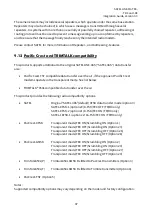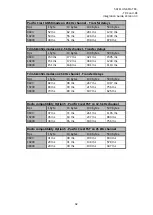
SATELLINE-M3-TR3,
–
TR4 and -R4
Integration Guide, Version 3.0
34
9.5
Priority RX/TX
Priority setting selects the priority between reception and transmission. The setting can be
changed either with Configuration Manager SW or via SL commands. By default, transmission
has higher priority than reception i.e. the default value is Priority TX.
Priority TX means that the device attached to a radio modem decides the timing of the
transmission. The transmitter is immediately switched on when the terminal device starts to
output data. Should reception be in progress, the radio modem will stop it and change to a
transmit state. There is no need to use any handshaking for the control of timing.
Priority RX means, that a radio tries to receive all data currently in the air. If a terminal device
outputs data to be transmitted (or an SL command) it will be buffered. The radio modem will
wait until the reception has stopped before transmitting the buffered data. This will result in
timing slacks to the system, but decreases the number of collisions on the air; this is particularly
useful in systems based on multiple random accesses.
9.6
Forward Error Correction (FEC)
FEC improves the reliability of data transfer over the radio by adding additional correction
information to the radio messages. Based on that information, the receiving radio modem will
be able to correct erroneous bits provided the ratio of erroneous and correct bits is reasonable.
However, the use of FEC decreases the data throughput, because the amount of transmitted
data increases about 30 % (see Appendix A). FEC should be used on long distance links and/or if
the radio channel is “noisy” in other words suffer
ing from interfering signals.
9.7
Error checking
When the error checking is switched on, the radio will add a checksum to the transmitted data.
When the data is received, the checksum is verified before data is forwarded to the serial port.
Options for error checking can be accessed either via SL commands or Configuration Manager
SW. Setting must be set equally for all radio modems in the same network. Error Check modes:
OFF (default setting).
Received data is not verified at all. In practice, this is the fastest way to
operate, because the data is given out from serial port immediately after it has been received.
This is recommended method, if the application protocol already includes error checking
functions.
NOTE!
All radio modems, which are to communicate with each other, must have the same
setting for FEC (ON or OFF). If the transmitting radio modem and the receiving radio modem
has different settings, data will not be received.
















































